Britain today recorded 10,641 coronavirus infections in the first week-on-week rise since the beginning of January, while deaths have tumbled to the lowest levels since mid-December with 178 new victims.
Department of Health figures show Covid cases are 9 per cent up on last Monday, when 9,765 were declared. But fatalities have dropped by almost a quarter, from 230. Today’s toll is the fewest daily deaths recorded since the 144 on December 13.
The figures come as Boris Johnson today defied huge pressure from Tories and business today to unveil an ultra-cautious ‘roadmap’ out of lockdown.
Announcing his long-awaited four-phase exit strategy, the Prime Minister warned the ‘threat remains’ and cases, hospitalisations and deaths will rise in the coming months as no vaccines can offer 100 per cent protection for the whole population.
Separate data also show Britain dished out just 150,000 vaccines yesterday, in the worst daily performance since the mammoth NHS roll-out began to gather speed last month. A successful inoculation drive is crucial to Britain’s hopes of lockdown being eased drastically in the next few month.
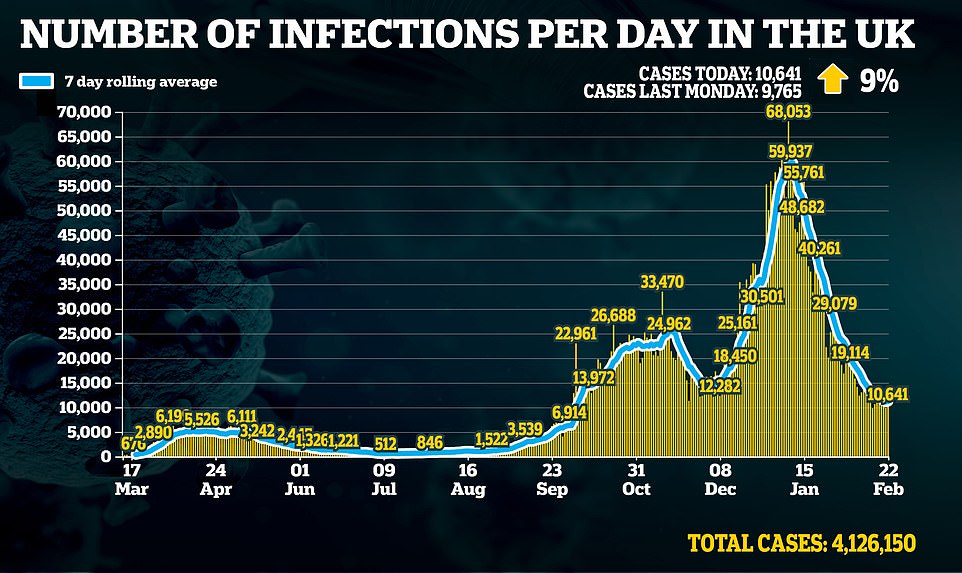
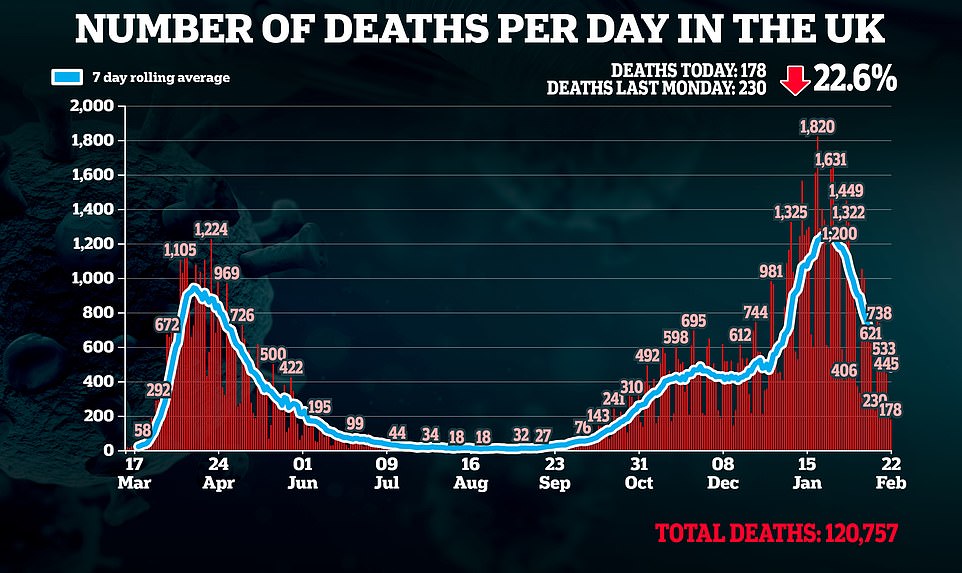

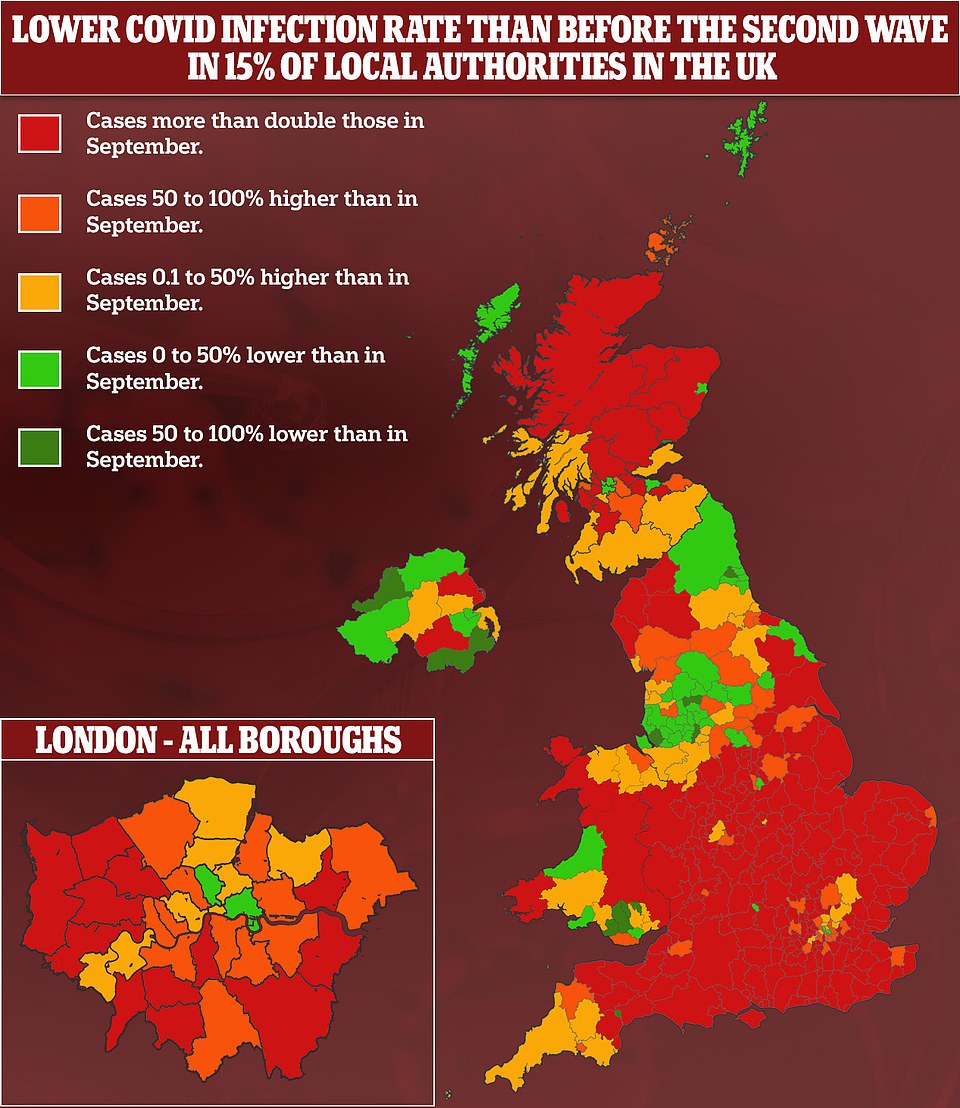
Covid vaccines being used in Britain are working ‘spectacularly well’
Covid vaccines being used in Britain are working ‘spectacularly well’ at slashing hospital admissions in Scotland and preventing even mild infections among health workers in England, the first real-world data revealed today.
Public Health England and top researchers in Scotland have published two separate papers linking up coronavirus data with vaccinations, revealing that jabs are both bringing down hospital admissions and preventing infections.
A single dose of Pfizer’s vaccine can cut the risk of testing positive with or without symptoms by 70 per cent, PHE found, rising to 85 per cent after a second jab.
And a dose of either Pfizer and AstraZeneca reduces someone’s risk of developing Covid severe enough to need hospital treatment by between 85 and 94 per cent, according to a separate study in Scotland.
PHE’s study showed that the Pfizer jab gave 57 per cent protection against Covid among over-80s from dose one, and this appeared to rise to 88 per cent after a second jab, although this data is preliminary. There was not enough information to make the same analysis for Oxford/AstraZeneca’s jab.
Experts dubbed the findings ‘very encouraging’, ‘a good sign’ and ‘reasons to be optimistic’ – they come as Boris Johnson today outlines Britain’s route out of lockdown, with schools expected to properly reopen in England from March 8, with further measures being loosed in the following weeks.
Government advisers on SAGE are still cautious, warning that 94 per cent protection ‘is not 100 per cent’ and that millions will still be at risk of Covid even with high vaccine coverage.
More than 17.5million people in the UK have had at least one dose of a coronavirus vaccine and vaccines minister Nadhim Zahawi said on Sky News today: ‘We wouldn’t be in this place this morning to be able to say that we’re going to reopen schools on March 8… if we’re not confident that, actually, the vaccine programme is beginning to really bear fruit.’
Advertisement
In other Covid developments today:
Teaching unions have demanded Boris Johnson scrap his plan to reopen all schools in England on March 8 in favour of a more cautious phased return to classrooms;Mr Zahawi said that the government was hoping this will be the last ‘severe’ coronavirus lockdown in England;Labour has insisted it supports schools reopening in full on March 8 despite opposition from teaching unions and Sir Keir Starmer saying there must be a considered approach;One in three adults have received a Covid jab as the government brings forward its target for vaccinating the whole population to July;Scientists have hailed early data showing the vaccines reduce transmission of coronavirus as well as easing its effects;The funeral of Captain Sir Tom Moore will be held on Saturday, in what the family said would be a ‘small’ service.
Discussing his four-stage lockdown-easing strategy, Mr Johnson told MPs: ‘At every stage our decisions will be led by data not dates.’
Mr Johnson said there will be a five-week gap between the main steps in the roadmap, even longer than had been anticipated.
He said it takes four weeks to assess the impact of each step, and the country needs a week’s notice for changes. Going any faster could mean having to reimpose the lockdown — but he added: ‘I won’t take that risk.
He admitted that the surging vaccine drive had encouraged many to think it is possible to ‘go faster’, and insisted that he understood their frustration but said: ‘To them I say the end really is in sight.’
The PM confirmed that all schools will reopen from March 8. But secondary pupils will need to wear masks in class for ‘weeks’ after the move – and there are precious few other easings until Easter, with scientists seemingly having won the battle for a slow approach.
The only other relaxation to come with schools returning is permission to meet socially with one friend or family member in the park for a coffee or a picnic.
The next stage of loosening will not be until March 29, when the formal Stay at Home edict is finally dropped in favour of ‘Stay Local’, and the Rule of Six makes a comeback. It will be extended to allow two households to gather, enabling relatives to meet properly for the first time in months.
That date will also see the reopening of tennis courts and golf courses and the return of grassroots football.
But shops, hairdressers and pubs must remain closed until April 12 at the earliest – the same time gyms can get back up and running – regardless of mounting fears about the economic meltdown. Even at that point pints and meals can only be consumed outdoors.
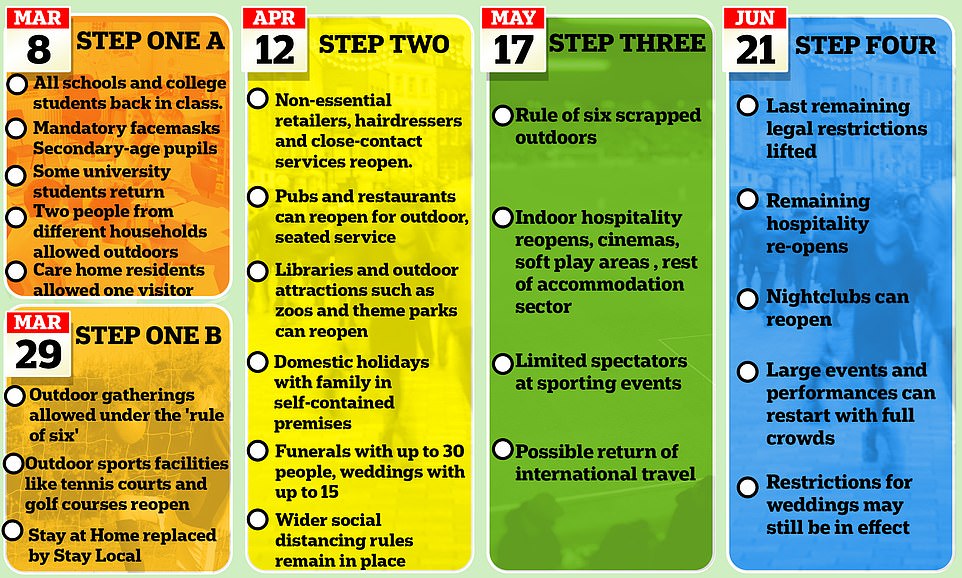
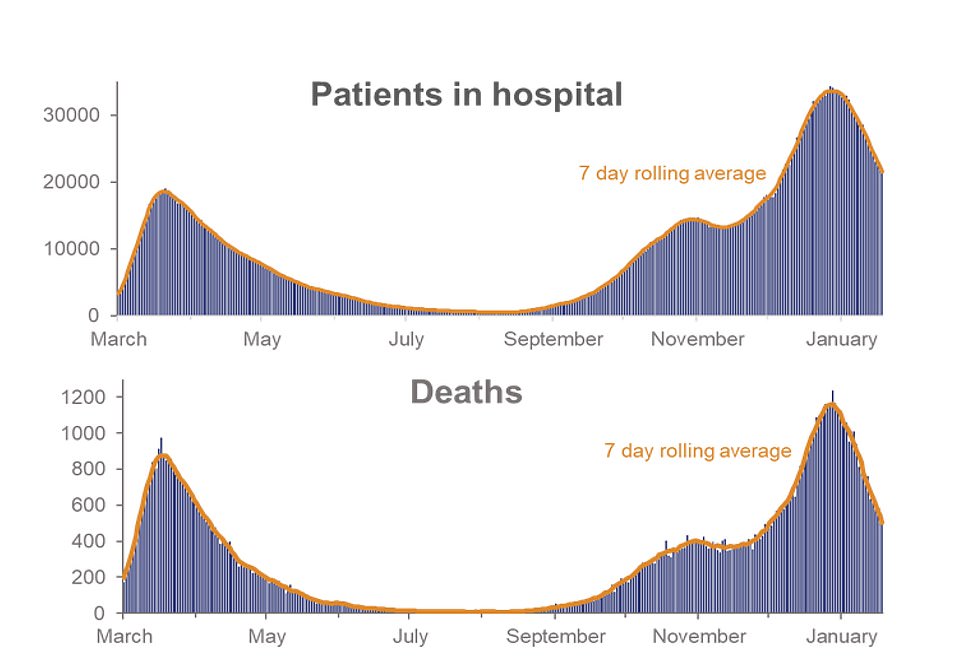
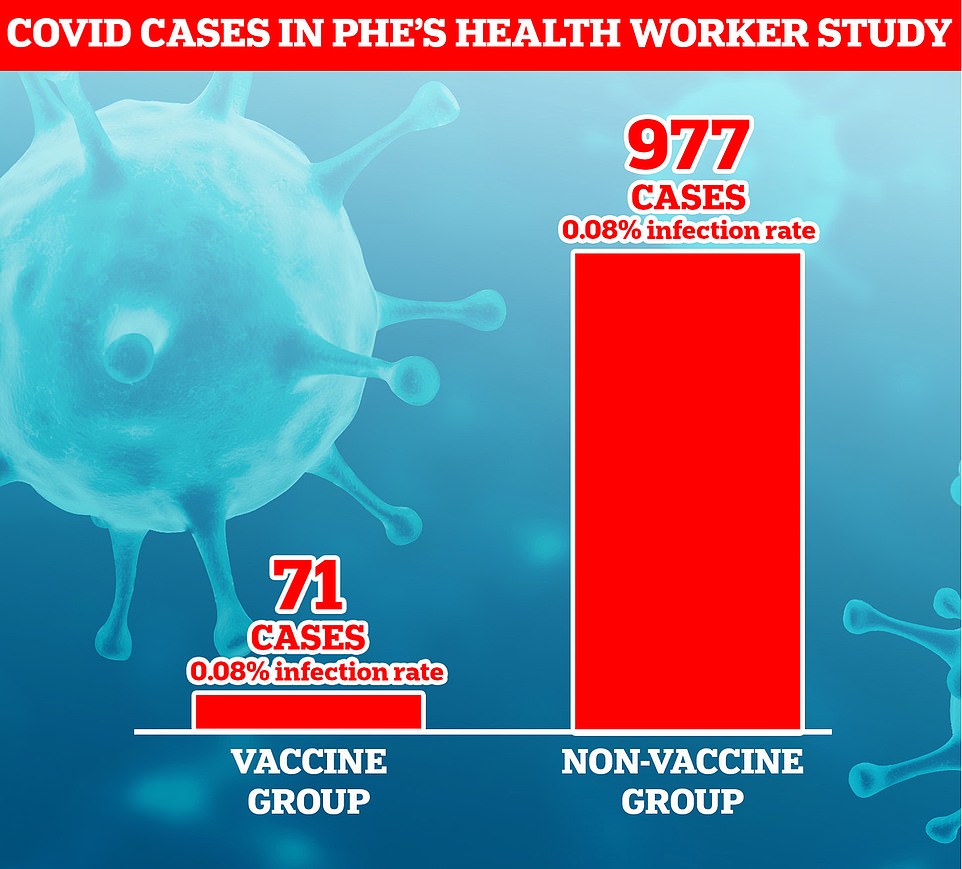
Out of 23,324 health workers in the study, 89 per cent were vaccinated by February 5. There were 977 cases of coronavirus recorded in people before they were vaccinated, compared to 71 among people who were three weeks post-vaccination, PHE’s Dr Susan Hopkins said today
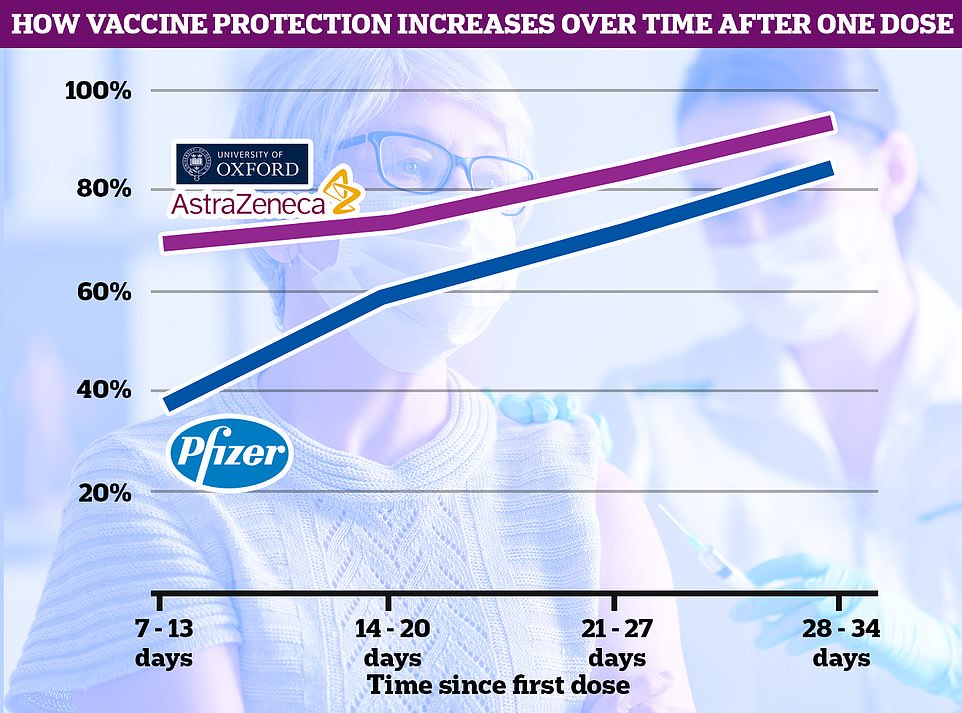
The Scottish study showed that both vaccines offer a high level of protection against being hospitalised with Covid from just two weeks after a single dose, with the protection kicking in only a week after injection. There were not enough data to compare the two, the scientists said, although AstraZeneca’s appears to work better in the early stages
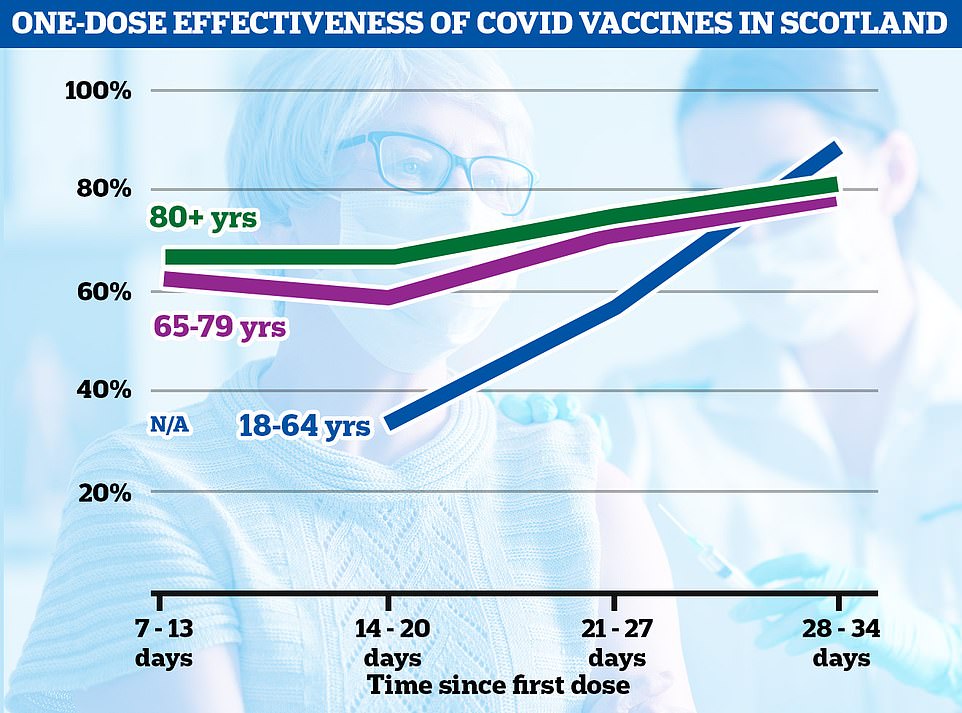
In a ray of hope for Britain’s lockdown-easing plans, results showed the jabs slashed the risk of hospital admission from Covid by up to 85 and 94 per cent, respectively, four weeks after the first dose. The graph above shows how the vaccine worked in different age groups
15% of authorities in the UK have smaller Covid outbreaks now than they did in September
Fifteen per cent of all local authorities in the UK had smaller coronavirus outbreaks than before the second wave spiralled out of control in September, MailOnline can reveal.
Department of Health figures showed 59 out of 380 councils across the country had a lower infection rate in the week ending February 16, the latest available, than in the seven-day spell to September 30.
Most of these areas are in the North of England and Wales which were recording more cases than the rest of the country in September, but two London boroughs – Islington and Tower Hamlets – and parts of the South East are also included.
The sharpest dips in infections compared to five months ago were in three areas – Newcastle-upon-Tyne, Manchester and Derry in Northern Ireland – where they were all more than 70 per cent lower.
It comes after Boris Johnson ironed out his ‘roadmap’ out of lockdown in England, with all pupils set to return to schools by March 8. Primary school pupils up to the age of eight have been allowed to return to their desks in Scotland and Wales today as part of a ‘phased reopening’.
Mr Johnson said relaxing measures would be subject to four tests – pace of the rollout, vaccine curbing infections, cases not risking a surge in hospitalisations and deaths and the spread of new variants – with all reviewed every four weeks before deciding whether to continue loosening measures.
Anti-shutdown Tory MPs have already condemned the tests as a ‘recipe for never unlocking’ as it emerges shops, salons, pubs and gyms will stay shuttered for months.
Advertisement
Campsites and holiday lets can reopen for single households from April 12 – but international travel is completely off the cards until at least May 17.
And social distancing rules will stay in force until June 21 at the minimum, with a government review to decide their future after that. The decision means that grandparents face months of waiting before they can hug their grandchildren – even though millions have already been vaccinated.
Another review will be held at that point to decide whether a system of vaccine certificates could be deployed within the UK to help open up the economy, something the government has previously said it is not considering.
Sports can start to return from May 17, although venues will need to work on reduced capacities.
Up to 30 people can go to weddings from the same date, but are stuck at that number until the next phase of the roadmap.
Only at June 21 will all legal limits on social contact go, and the remaining elements of the hospitality sector be allowed to open.
The PM stressed that he is being driven by ‘data not dates’ and the timeline is not guaranteed.
The blueprint, which runs to 60 pages, includes a raft of modelling supporting No10’s tentative strategy. It was published alongside further positive news about the effectiveness of jabs in reducing transmission.
A major study published today found they were working ‘spectacularly well’ and cutting hospital admissions by as much as 95 per cent.
But Mr Johnson ran the gauntlet of anger on his own benches this afternoon, as he set four tests for continuing with any easing including no new concerns emerging about variant strains.
The other criteria are the vaccine rollout going well, jabs being effective at reducing hospital admissions and deaths, and avoiding a surge in hospital cases.
Notably the rules do not mean that the loosening must stop if infections rise – as ministers believe they inevitably will when schools open.
Instead the focus will be on serious illness that increases pressure on the NHS, with the goal of keeping the R number below one apparently downgraded.
Mr Johnson dropped a strong hint that furlough could be extended beyond the end of April amid the slow relaxation, saying the government will keep doing ‘all it takes’ to prop up jobs and firms.
Boris Johnson’s lockdown exit strategy in full: All schools back on March 8, two households meeting outdoors from March 29, non-essential shops, pubs and hairdressers open from April 12 and back to normal on June 21
Boris Johnson today unveiled his lockdown exit strategy which could see life in England return to something close to normal by June at the earliest.
The Prime Minister’s plan for easing restrictions will be split into four separate steps and will see the country treated as a whole, with no return to a tier system.
The loosening of lockdown will begin on March 8 when all schools across the country will return.
Rules will then be lifted at five-weekly intervals to allow four weeks to measure the impact of changes and to give a further week’s notice before the next step comes into force.
However, the Government has stressed that the dates set out in the roadmap are ‘not before dates’ and that they could change depending on the scale of the coronavirus outbreak.
Below is a breakdown of the measures outlined in each step:
Step One Part One: March 8
From March 8, all pupils and students will return to schools and colleges across England.
University students who require practical teaching to complete their studies will also be allowed to return.
But university students who do not need practical teaching will still be banned from campuses with ministers due to conduct a review by the end of the Easter holidays on the options for their return.
So-called wrap-around childcare will also be allowed to resume, paving the way for before and after school clubs to restart.
People will be allowed to meet one other person outside for recreation, for example, to have a picnic or to meet for coffee.
Meanwhile, care home residents will be able to have one regular named visitor.
The Government’s stay at home order will remain in place, with travel for non-essential purposes still banned.
Step One Part Two: March 29
From March 29, outdoor gatherings of up to six people or a larger group from up to two households will be allowed. These gatherings will be allowed to happen in private gardens as well as in public spaces like parks.
Outdoor sports like tennis and basketball will be allowed to resume and people will also be able to take part in formally organised outdoor sports.
It is at this point that the Government’s stay at home guidance will end, to be replaced by ministers encouraging people to ‘stay local’.
However, the Government is not expected to define exactly what constitutes local, instead choosing to rely on people using their common sense to decide on journeys.
People will still be told to work from home wherever possible while international travel will still be banned unless it is for essential purposes.
Step Two: April 12
Non-essential retail will be allowed to reopen as well as personal care businesses like hairdressers, barbers and nail salons.
Public buildings like libraries, museums and art galleries will be allowed to welcome back customers.
Meanwhile, hospitality venues and outdoor attractions like theme parks will be given the green light to reopen in some form.
However, there will still be rules on household mixing: Essentially any activity which involves being indoors will be restricted to members of the same household.
Gyms and swimming pools will also reopen from April 12 but only on the basis that people go on their own or with members of their own household.
Pubs and restaurants will be able to reopen but at this point they will only be able to have customers outdoors.
Any visits to a pub or restaurant will have to comply with the rules on social contact, so no more than two households or the rule of six.
The Government will not be bringing back the old requirement for people to order a substantial meal with alcohol while the old 10pm curfew will also be ditched.
All customers at hospitality venues will have to be seated when they order food or drink, with ordering at the bar prohibited.
Campsites and holiday lets where indoor facilities are not shared with other households can also reopen but trips must be restricted to a single household.
Funerals will be allowed to continue with up to 30 people, while the rules on wedding receptions will be eased to allow the number of guests to increase from six to 15.
The Government will also launch pilot programmes in April to see how events with large crowds and reduced social distancing could work.
A new task force looking at how to increase inbound and outbound international travel, while also protecting against importing coronavirus variants, will report on April 12.
The expectation is that international travel will not resume until May 17 at the very earliest.
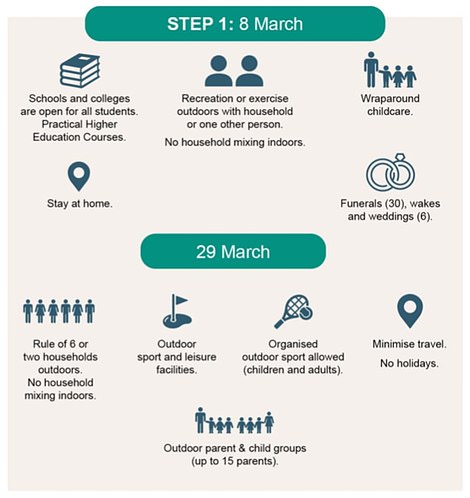
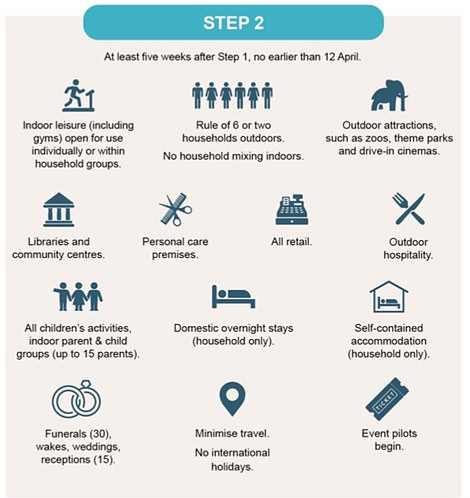
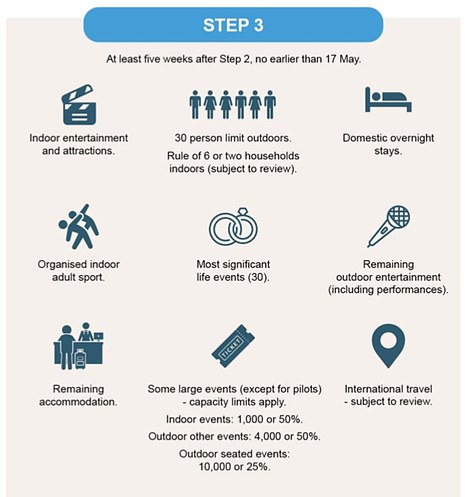
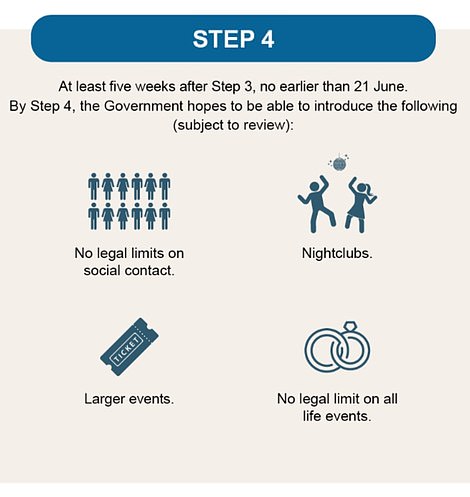
Step Three: May 17
The two household and rule of six requirements for outdoor gatherings will be ditched but gatherings of more than 30 people in places like parks will still be banned.
Crucially, mixing indoors will be allowed again. The rule of six or a larger group from up to two households will be allowed to meet.
However, this will be kept under review by ministers to see if rules could be relaxed still further.
This is also the point at which pubs and restaurants and other hospitality venues will be able to open indoors, with the rule of six and two household limit in place. Larger groups will be able to meet outdoors at a pub.
Entertainment venues like cinemas and children’s play areas will be able to reopen, as will hotels and B&Bs. Indoor adult sports groups and exercise classes can also reopen.
Changes will also be made to sporting and performance events in indoor venues with a capacity of 1,000 people or half full, whichever is lower, will be allowed, while outdoors a capacity of 4,000 people will be allowed or half full, whichever is lower.
In the biggest outdoor stadiums, up to 10,000 fans will be allowed to attend matches or a quarter of capacity, whichever is lower.
Rules on weddings will be eased further, with up to 30 people allowed to attend receptions as well as other life events including christenings.
A Government review on whether to introduce vaccine passports or ‘Covid Status Certification’ documents is due to report before Step Four.
It will look at whether the documents, which could show if someone has been tested or if they have had a jab, could help to reopen the economy and make life easier.
Step Four: June 21
This is the point at which the Government is hoping to lift all of the remaining restrictions on social contact and to reopen sectors of the economy which have not already returned and which could not resume last summer.
For example, this is when night clubs could be allowed to fully reopen while restrictions on large events and performances could also be lifted.
Mass-testing could be used to to reduce the risk of infection at those settings.
The Government will also make a decision on whether all restrictions can be removed on weddings and other life events.
Source link : https://www.dailymail.co.uk/news/article-9287473/Covid-cases-time-SIX-WEEKS-10-641-new-infections.html











